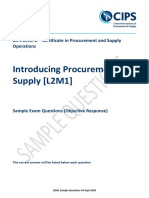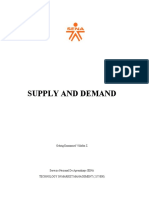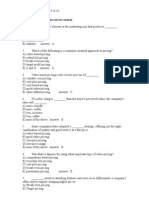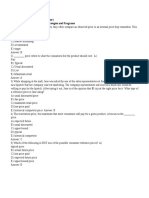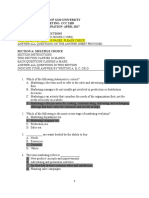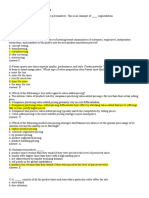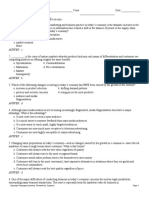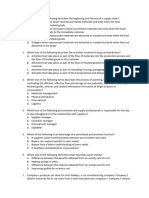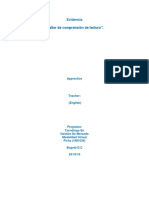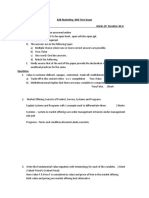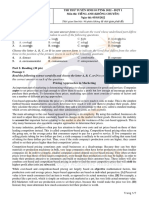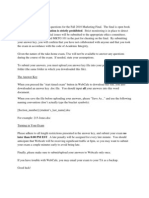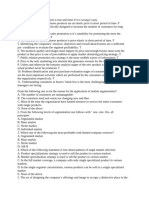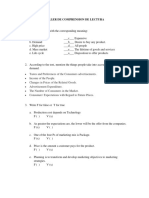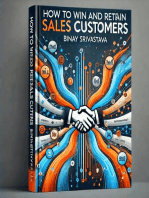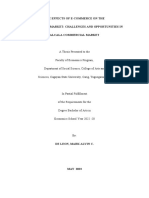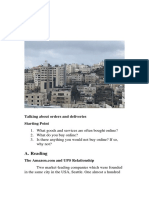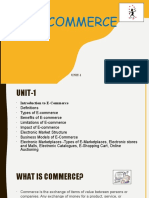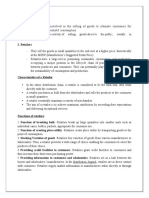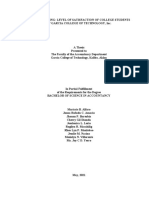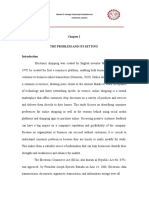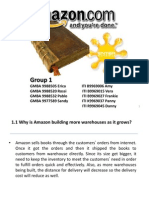0 ratings0% found this document useful (0 votes)
3 viewsChapter 11
Chapter 11
Uploaded by
evelynhrdz32Copyright:
© All Rights Reserved
Available Formats
Download as DOCX, PDF, TXT or read online from Scribd
Chapter 11
Chapter 11
Uploaded by
evelynhrdz320 ratings0% found this document useful (0 votes)
3 views4 pagesCopyright
© © All Rights Reserved
Available Formats
DOCX, PDF, TXT or read online from Scribd
Share this document
Did you find this document useful?
Is this content inappropriate?
Copyright:
© All Rights Reserved
Available Formats
Download as DOCX, PDF, TXT or read online from Scribd
Download as docx, pdf, or txt
0 ratings0% found this document useful (0 votes)
3 views4 pagesChapter 11
Chapter 11
Uploaded by
evelynhrdz32Copyright:
© All Rights Reserved
Available Formats
Download as DOCX, PDF, TXT or read online from Scribd
Download as docx, pdf, or txt
You are on page 1of 4
Chapter 11: Product, Price, and Place
Part 1: Content Review
Matching
Choose the letter of the correct term for each definition.
Terms:
A. intangible
B. warranty
C. quality
D. guarantee
E. price floor
F. loss leader
G. markup
H. base price
I. e-tailers
J. supply chain
1. Pricing an item much lower than the current market price or the cost of acquiring the product.
Answer: loss leader
2. The general price at which the company expects to sell the product.
Answer: Base price
3. Something that cannot be touched.
Answer: intangible
4. The minimum price set by the government for certain goods and services that it thinks are
being priced too low.
Answer: price floor
5. A written document that states the quality of a product with a promise to correct certain
problems that might occur.
Answer: warranty
6. The amount added to the cost to determine the selling price.
Answer: markup
7. A promise that a product has a certain quality or will perform in a certain way.
Answer: guarentee
8. Retailers that sell products through websites.
Answer: e-tailers
9. The businesses, people, and activities involved in turning raw materials into products and
delivering them to end users.
Answer: supply chain
10. An indicator of a product’s excellence.
Answer: quality
Multiple Choice
Choose the letter of the correct answer to each question.
1. Which of the following is a characteristic of a service?
A. Can be stored
B. Can be repeated in exactly the same way
C. Mass produced
D. Intangible
Answer: D
2. Which of the following is an example of a basic category of consumer product?
A. Convenience good
B. Process material
C. Component part
D. Raw materials
Answer: A
3. Which of the following is not a business product category in the business-to-business (B2B)
market?
A. Raw materials
B. Process materials
C. Major equipment
D. Shopping goods
Answer: D
4. The price of a good or service must _____.
A. be lower than what customers are willing to pay
B. be below any government price floor
C. cover the cost of producing and selling the product
D. not be below the manufacturer’s suggested retail price (MSRP)
Answer: C
5. Which of the following is an example of a pricing objective?
A. Minimize cost
B. Minimize profit
C. Maximize profit
D. Minimize the product life cycle
Answer: C
6. During which stage of the product life cycle are the sales and prices of products stable?
A. Introduction
B. Growth
C. Maturity
D. Decline
Answer: C
7. A product starts making a profit after reaching the _____.
A. growth stage of the product life cycle
B. break-even point
C. price ceiling
D. mass market
Answer: B
8. The path of selling goods or services directly from a manufacturer to end users without using
intermediaries is the _____.
A. supply chain
B. direct channel
C. indirect channel
D. pipeline
Answer: B
9. Which is not a basic type of product created by a producer?
A. Natural resources
B. Transportation
C. Agricultural products
D. Finished goods
Answer: B
10. Buyers and sellers are brought together by _____.
A. agents
B. wholesalers
C. distributors
D. rack jobbers
Answer: A
Completion
Choose the word(s) that best completes each of the following statements.
1. The _____ price is the amount a customer pays for a product.
Answer: selling
2. The _____ is the stages a product goes through from its beginning to end.
Answer:
3. A reduced per-item price for larger numbers of an item purchased is a(n) _____.
Answer:
4. The practice of _____ is advertising one product with the intent of persuading customers to
buy a more expensive item when they arrive in the store.
Answer:
5. The practice of setting very low prices to remove competition is _____.
Answer:
6. Raising prices on certain kinds of goods to an excessively high level during an emergency is
_____.
Answer:
7. The physical movement of products through the channel of distribution is _____.
Answer:
8. Companies that organize shipments are _____.
Answer:
9. A(n) _____ purchases large amounts of goods directly from manufacturers, stores them, and
then resells in smaller quantities to various retailers.
Answer:
10. The process of separating a large quantity of goods into smaller quantities is _____.
Answer:
You might also like
- Introducing Procurement and Supply (L2M1)Document7 pagesIntroducing Procurement and Supply (L2M1)Louise Bagus Sutrisno75% (4)
- Business PlanDocument32 pagesBusiness PlanArvind Sanu Misra100% (6)
- 13.1 Objective 13.1: Chapter 13 Pricing Decisions and Cost ManagementDocument43 pages13.1 Objective 13.1: Chapter 13 Pricing Decisions and Cost ManagementAlanood WaelNo ratings yet
- Supply and Demand Reading Comprehension ACTDocument4 pagesSupply and Demand Reading Comprehension ACTGehrig VillalbaNo ratings yet
- Entrp Part 1Document6 pagesEntrp Part 1Lindbergh SyNo ratings yet
- ch09 PDFDocument55 pagesch09 PDFMohammed AljabriNo ratings yet
- Research Proposal E-RetailingDocument10 pagesResearch Proposal E-RetailinghunnygoyalNo ratings yet
- REVISION - Chapter 9 & 10 SECTION 1: Circle The Correct AnswerDocument8 pagesREVISION - Chapter 9 & 10 SECTION 1: Circle The Correct AnswerRaza ArshadNo ratings yet
- Marketing Assignment 2Document294 pagesMarketing Assignment 2aman91330No ratings yet
- CH 16Document15 pagesCH 16mah bNo ratings yet
- MM Chapter 14 Test BankDocument9 pagesMM Chapter 14 Test BankkarimNo ratings yet
- Economics For ManagersDocument73 pagesEconomics For ManagersSwapnil DeshpandeNo ratings yet
- Entrep Summative Test 2 Sy 21 22Document2 pagesEntrep Summative Test 2 Sy 21 22Elle GatchNo ratings yet
- Principles of Marketing TestDocument10 pagesPrinciples of Marketing TestCL PalisNo ratings yet
- MKT p2Document17 pagesMKT p2sourabhNo ratings yet
- Tugas 1 Bhs. Inggris NiagaDocument2 pagesTugas 1 Bhs. Inggris Niagabudi astitiNo ratings yet
- Principles of MarketingDocument11 pagesPrinciples of Marketingkondwani B J MandaNo ratings yet
- Chapter 11Document8 pagesChapter 11Abdullah JuttNo ratings yet
- MCQs With PDF DownloadDocument10 pagesMCQs With PDF Downloadsujit kangsabanikNo ratings yet
- Principles of MKTNG Q4 Module 2 For StudentsDocument15 pagesPrinciples of MKTNG Q4 Module 2 For StudentsRich Allen Mier UyNo ratings yet
- Chapter 13 Developing Pricing Strategies and Programs: Marketing Management, 14e (Kotler/Keller)Document40 pagesChapter 13 Developing Pricing Strategies and Programs: Marketing Management, 14e (Kotler/Keller)vnbcfnbNo ratings yet
- Air SHS Abm PM Q4 Mod11 PDFDocument17 pagesAir SHS Abm PM Q4 Mod11 PDFJade ivan parrochaNo ratings yet
- Marketin 2 Vize SorularıDocument3 pagesMarketin 2 Vize SorularıKatre-i MatemNo ratings yet
- Applied Economics 2122 1Document31 pagesApplied Economics 2122 1Hazel EmlanoNo ratings yet
- MKT 100 Final 3Document22 pagesMKT 100 Final 3chicbooNo ratings yet
- Chapter 1 Marketing in Today S EconomyDocument8 pagesChapter 1 Marketing in Today S EconomyDina KikiNo ratings yet
- Quản trị marketing tiếng AnhDocument30 pagesQuản trị marketing tiếng AnhNguyen Ngoc Phuong AnhNo ratings yet
- L2M1 mockNO ANSWERSDocument12 pagesL2M1 mockNO ANSWERSk.kgabukiNo ratings yet
- PART-A (1-Mark)Document92 pagesPART-A (1-Mark)pnityanandanNo ratings yet
- ME MCQDocument30 pagesME MCQrkhadke1No ratings yet
- MKT 100 Final 4Document22 pagesMKT 100 Final 4chicbooNo ratings yet
- SUMMATIVE TEST Module 5-6Document4 pagesSUMMATIVE TEST Module 5-6Jessuel Larn-epsNo ratings yet
- Strictly No Erasure Test I. Multiple ChoiceDocument6 pagesStrictly No Erasure Test I. Multiple ChoiceRia Dela CruzNo ratings yet
- Summary of ResultsDocument3 pagesSummary of ResultsTARIQKHAN747No ratings yet
- Supply and DemandDocument10 pagesSupply and Demandyarle elianaNo ratings yet
- Principles of Mktg-Q4-Module-2Document32 pagesPrinciples of Mktg-Q4-Module-2Edson Liganan100% (1)
- Revision L3M2 PDFDocument38 pagesRevision L3M2 PDFphatsimombapusaNo ratings yet
- B2B Marketing - Jyoti - Sagar - P19052Document5 pagesB2B Marketing - Jyoti - Sagar - P19052JYOTI TALUKDARNo ratings yet
- Major Exam On Ms With AnswersDocument8 pagesMajor Exam On Ms With AnswersPauline De Villa100% (1)
- Price QsDocument16 pagesPrice Qsahmedjojo6088No ratings yet
- Thi thử PTNK 2022 Lần 1 Anh Không chuyênDocument7 pagesThi thử PTNK 2022 Lần 1 Anh Không chuyênTrung Kiên NguyễnNo ratings yet
- Final ExamDocument18 pagesFinal Examnmfreedom100% (2)
- Quiz Techno Group1 ECEEEMEDocument2 pagesQuiz Techno Group1 ECEEEMEJohn Mark BallesterosNo ratings yet
- Marketing QuizDocument4 pagesMarketing QuizgebremedhnNo ratings yet
- Multiple Choice QuestionsDocument2 pagesMultiple Choice QuestionsMuthusamy SenthilkumaarNo ratings yet
- ME RiooDocument12 pagesME RiooRiyaad MandisaNo ratings yet
- Part 3-Cia Exam Preparation 101 QUESTIONS 2019Document44 pagesPart 3-Cia Exam Preparation 101 QUESTIONS 2019ʚïɞ Fi Fi ʚïɞ100% (1)
- Acc102 FinalReviewDocument31 pagesAcc102 FinalReviewTiffany Beth Carlton100% (1)
- Ap04-Ev04 Taller de Comprension de LecturaDocument3 pagesAp04-Ev04 Taller de Comprension de LecturaNELCY YULIETH CONTRERAS SANCHEZ100% (4)
- MM QuizDocument9 pagesMM QuizSanjay VinceNo ratings yet
- It's Better To Get ZERO, Than To CHEAT.Document2 pagesIt's Better To Get ZERO, Than To CHEAT.Dan Pacyao MirasNo ratings yet
- Defining Business Needs - ExamsDocument10 pagesDefining Business Needs - ExamsAlbert MawonekeNo ratings yet
- Cips L2M3Document7 pagesCips L2M3knightshahz18No ratings yet
- Exam 21Document12 pagesExam 21bojasenbeta28No ratings yet
- Test Paper 1 - MarketingDocument5 pagesTest Paper 1 - MarketingAbhijit DasNo ratings yet
- FP Quarter 4 Summative Test 1 P. MarketingDocument2 pagesFP Quarter 4 Summative Test 1 P. Marketingnicole cascanteNo ratings yet
- Chapter 14Document2 pagesChapter 14abu.toyabNo ratings yet
- Earfly Mfo3ver Adv3antDocument10 pagesEarfly Mfo3ver Adv3antpaulx93xNo ratings yet
- Mark Alvin de Leon Research Chapter 1 2 MidtermDocument12 pagesMark Alvin de Leon Research Chapter 1 2 MidtermMark Alvin De LeonNo ratings yet
- Module 7Document13 pagesModule 7Asti SariNo ratings yet
- E Commerce - Unit 1Document21 pagesE Commerce - Unit 1Bhimarasetty CherishNo ratings yet
- Team 5Document2 pagesTeam 5Mai Lâm LêNo ratings yet
- Test Case IDP LL Report 4Document7 pagesTest Case IDP LL Report 4MD Sajjat HosenNo ratings yet
- JDocument15 pagesJkhuzaima alamNo ratings yet
- Consumer Perception Towards Online Buying Behaviour of Lenskart Product in GujaratDocument9 pagesConsumer Perception Towards Online Buying Behaviour of Lenskart Product in GujaratSakchi AgarwalNo ratings yet
- Consumer Perception Study On Bigbasket and GrofersDocument25 pagesConsumer Perception Study On Bigbasket and GrofersShubham SaraogiNo ratings yet
- Consumer Protection LawDocument13 pagesConsumer Protection LawAnand YadavNo ratings yet
- HFD 111Document2 pagesHFD 111Mark Anthony EstacioNo ratings yet
- Role of Utilitarian Motivation On Socal Media Shopping Behavior (Extended Abstract)Document6 pagesRole of Utilitarian Motivation On Socal Media Shopping Behavior (Extended Abstract)Jarelle Rose GaditNo ratings yet
- RXUK TOP500 2020 v2Document48 pagesRXUK TOP500 2020 v2Íñigo PérezNo ratings yet
- Returns Re-Label Process Standardization at Ekart Logistics, ChennaiDocument54 pagesReturns Re-Label Process Standardization at Ekart Logistics, ChennaiNaveen KumarNo ratings yet
- Gamma-J Usb Web Store SrsDocument44 pagesGamma-J Usb Web Store Srsaditya181987No ratings yet
- Retailing Malls Format in IndiaDocument2 pagesRetailing Malls Format in IndiaMamatha KerpudeNo ratings yet
- RTL - MGT AnsDocument32 pagesRTL - MGT AnsAllan Edward GJNo ratings yet
- Literature Review Example Consumer BehaviourDocument5 pagesLiterature Review Example Consumer Behaviourafmzfxfaalkjcj100% (1)
- E CommerceDocument31 pagesE CommerceSadhna MishraNo ratings yet
- Online Book Store Final - SmitaDocument39 pagesOnline Book Store Final - SmitaSmita Somani67% (3)
- Final 1 3Document24 pagesFinal 1 3Gj VillorenteNo ratings yet
- EOI - DataKart Stack RevampDocument13 pagesEOI - DataKart Stack Revampdebanshu GhoshNo ratings yet
- Main Body of The Research PaperDocument82 pagesMain Body of The Research PaperJILLIAN JOY RUBYNo ratings yet
- AmazonDocument9 pagesAmazonfaisal_csedu0% (1)
- Ahmed Kada Morocco PostDocument15 pagesAhmed Kada Morocco PostivanaixiNo ratings yet
- Canadian Tire's Growth StrategyDocument31 pagesCanadian Tire's Growth StrategySriram Venkataramani100% (1)
- Instructor's ManualDocument13 pagesInstructor's ManualM MNo ratings yet
- Fpsyg 13 1019024Document17 pagesFpsyg 13 1019024thongphan.31221026912No ratings yet
